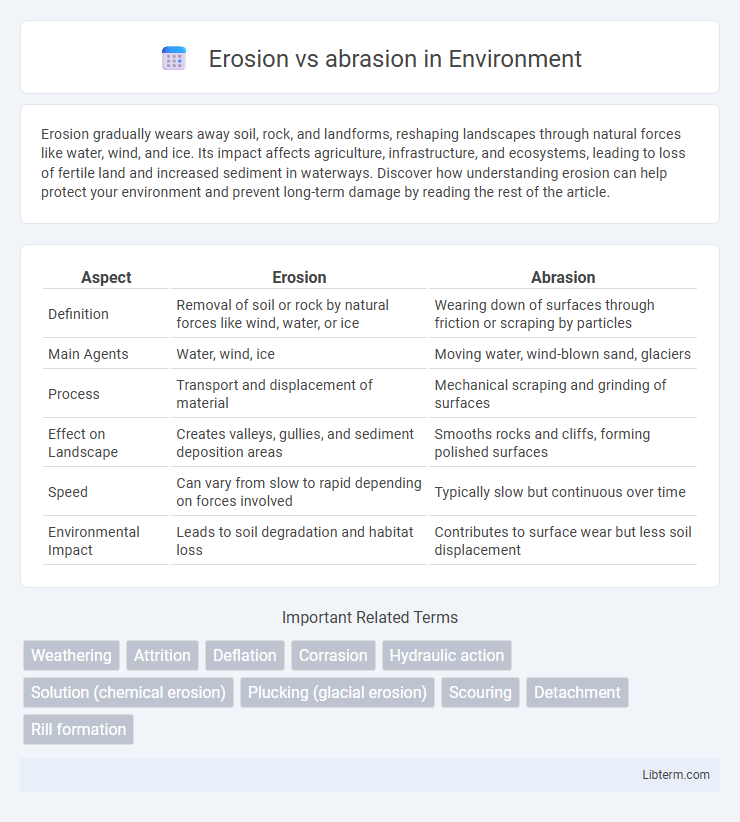Erosion gradually wears away soil, rock, and landforms, reshaping landscapes through natural forces like water, wind, and ice. Its impact affects agriculture, infrastructure, and ecosystems, leading to loss of fertile land and increased sediment in waterways. Discover how understanding erosion can help protect your environment and prevent long-term damage by reading the rest of the article.
Table of Comparison
| Aspect | Erosion | Abrasion |
|---|---|---|
| Definition | Removal of soil or rock by natural forces like wind, water, or ice | Wearing down of surfaces through friction or scraping by particles |
| Main Agents | Water, wind, ice | Moving water, wind-blown sand, glaciers |
| Process | Transport and displacement of material | Mechanical scraping and grinding of surfaces |
| Effect on Landscape | Creates valleys, gullies, and sediment deposition areas | Smooths rocks and cliffs, forming polished surfaces |
| Speed | Can vary from slow to rapid depending on forces involved | Typically slow but continuous over time |
| Environmental Impact | Leads to soil degradation and habitat loss | Contributes to surface wear but less soil displacement |
Introduction to Erosion and Abrasion
Erosion is the natural process where soil, rock, and sediment are worn away and transported by wind, water, or ice, significantly shaping landscapes over time. Abrasion specifically refers to the mechanical scraping or grinding of surfaces, such as rocks or soil, caused by friction from particles carried by water, wind, or glaciers. Understanding the differences between erosion and abrasion helps in managing soil conservation and mitigating environmental impacts.
Defining Erosion: Causes and Processes
Erosion is the geological process involving the removal and transportation of soil, rock, and sediment by natural forces such as water, wind, ice, or gravity. Key causes include rainfall runoff, river flow, glacial movement, and coastal wave action, which gradually wear away land surfaces over time. Unlike abrasion, which refers specifically to the mechanical scraping of rock surfaces, erosion encompasses a broader range of processes that collectively shape landscapes and influence soil fertility.
Understanding Abrasion: Mechanisms and Examples
Abrasion is a mechanical process where rock surfaces are worn down by friction caused by particles transported by wind, water, or ice. Common examples include sandpaper smoothing wood, glaciers grinding bedrock, and rivers carrying sediment that scrapes riverbeds. This continuous friction results in the gradual wearing away of surfaces, distinguishing abrasion from chemical erosion, which involves mineral dissolution.
Key Differences Between Erosion and Abrasion
Erosion involves the transportation of soil, rock, or sediment by natural agents such as water, wind, or ice, significantly altering landscapes over time. Abrasion specifically refers to the mechanical scraping or wearing down of surfaces due to friction from particles carried by water, wind, or glaciers. While erosion encompasses the broader process of material removal and relocation, abrasion is a localized surface degradation caused by direct physical contact.
Natural Agents Involved in Erosion
Natural agents involved in erosion primarily include water, wind, ice, and gravity, which systematically wear away soil and rock surfaces. Water erosion occurs through rainfall, rivers, and ocean waves, transporting sediments and reshaping landscapes, while wind erosion affects arid and semi-arid regions by lofting fine particles into the atmosphere. Glacial ice contributes to erosion via abrasion as glaciers move slowly, grinding underlying rock, and gravity causes mass wasting events like landslides that rapidly displace earth materials.
Factors Influencing Abrasion
Abrasion is primarily influenced by the hardness and size of the particles involved, the speed and volume of the transporting medium such as water or wind, and the duration of contact between particles and surfaces. The mineral composition of the impacted surface and the moisture content can also significantly affect the rate of abrasion. These factors collectively determine the efficiency and extent of material wearing away in natural and industrial environments.
Environmental Impacts of Erosion
Erosion significantly alters landscapes by removing topsoil, leading to habitat destruction and reduced agricultural productivity. The loss of fertile soil from erosion increases sedimentation in water bodies, causing water pollution and damaging aquatic ecosystems. In contrast, abrasion mainly affects physical surfaces but contributes less directly to widespread environmental degradation compared to erosion.
Effects of Abrasion on Landscapes and Materials
Abrasion significantly alters landscapes by wearing down rock surfaces through friction caused by particles transported by wind, water, or glaciers, leading to smoother and flattened terrains. This process can degrade materials such as building stones, metals, and coatings, resulting in surface roughness, material loss, and structural weakening over time. In sedimentary environments, abrasion shapes sediment grain size and texture, influencing soil formation and ecosystem development.
Prevention and Control Methods for Erosion and Abrasion
Prevention and control methods for erosion include planting vegetation to stabilize soil, constructing barriers such as retaining walls or riprap, and implementing terracing or contour plowing to reduce water runoff. Abrasion control involves using protective coatings on surfaces, selecting abrasion-resistant materials like hardened steel or polyurethane liners, and maintaining equipment regularly to minimize wear. Both erosion and abrasion prevention rely on monitoring environmental conditions and applying targeted engineering solutions to mitigate damage effectively.
Conclusion: Choosing the Right Approach to Surface Wear
Erosion involves the removal of material caused by fluid or particle impact, while abrasion results from mechanical scraping or friction between surfaces. Selecting the appropriate approach to surface wear depends on the specific environment and operational conditions, such as particle size, hardness, and fluid dynamics. Understanding these factors ensures effective material protection and longevity in industrial and natural applications.
Erosion Infographic

 libterm.com
libterm.com